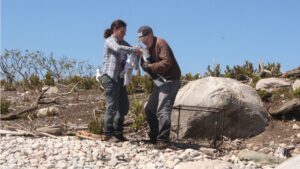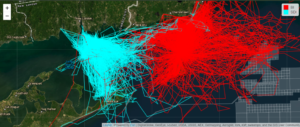
Research Abounds on Avalonia Preserves
By Lili Kane
Pike Marshall, Barrett, Sheets, South Dumpling Island, and Downes, Paffard, and Cottrell Marshes are among the numerous Avalonia properties that have hosted academic studies this past spring and summer. The work has been diverse, including mammalian, avian, vegetation, and soil or substrate studies.
While a number of these studies are localized, one has been somewhat more wide-ranging, encompassing portions of Rhode Island, New York, and Connecticut. On Avalonia’s South Dumpling Island (Southhold, NY) and nearby Block Island, RI, Dr. Peter Paton, professor of natural resources science at the University of Rhode Island, and Dr. Juliet Lamb, a marine scientist with The Nature Conservancy, have been busy researching Great Black-backed Gull behavioral and migration ecology. Recent advancements in transmitter technology have expanded the possibilities in this field, allowing research on both local and regional patterns of movement.

In late May of this year, Drs. Paton and Lamb placed 10 transmitters on South Dumpling Island gulls and 9 transmitters on Block Island gulls, each transmitter being 25 grams, solar-powered, and with a ‘backpack’ style harness. Collecting the GPS location of gulls every 20 minutes, 24/7, they have made preliminary insights into how the birds from these distinct populations interact.

Initial mapping of gull movement is illustrated in the rendering to the right. The blue lines represent gulls originally tagged on South Dumpling Island with red lines representing gulls tagged on Block Island. So far there has been relatively little overlap between these two populations, each staying fairly close to the location where they were initially tagged.

The exception is two adventurous birds from Block Island, one that has traveled as far south as New Jersey and the other as far north as Nantucket in Massachusetts, their journeys visible in the higher-scale image. These results are preliminary, and continual monitoring of Black-back gull movement will be conducted. The hope is that these investigations will yield a better understanding of Black-back gull foraging and migration ecology. Over time, Avalonia will look forward to the analysis of the full body of data with a view toward the possibility of incorporating any recommendations into our management plan for South Dumpling Island.
